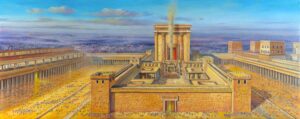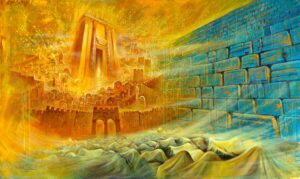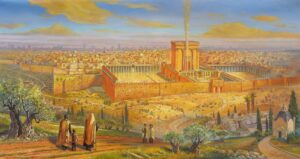
The construction of the Beit Hamikdash in Jerusalem has been a focal point in Jewish history since the days of King Solomon. This monumental temple has been the site of many spiritual, religious and ritualistic services throughout its time. Through the ages, it has been the home of Hashem’s presence, a place where the Divine revealed itself to the Jewish people. In this article, we will explore the history, the spiritual significance, and other key features of the Beis Hamikdash in Jerusalem.
The History of the Beit Hamikdash in Jerusalem
The first Beit Hamikdash was built by King Solomon in 957 BCE and it stood for 420 years. It was destroyed by the Babylonians in 586 BCE and the Jews were exiled from the Land of Israel. The second Beit Hamikdash was built in 515 BCE by King Herod and was destroyed by the Romans in 70 CE. After the destruction of the Second Temple, Jewish leaders mourned its demise and fasted in remembrance. The third Beit Hamikdash was never completed due to the onset of exile and will only be built upon the arrival of the Moshiach.
Exploring the Spiritual Significance of the Beis Hamikdash
The Beis Hamikdash was a place of unparalleled holiness and its spiritual significance is a core aspect of our Jewish faith. This holy site was home to the Divine Presence; the Kohanim and Leviim conducted services there and the Jewish people worshipped Hashem. The Beit Hamikdash provided a direct connection to Hashem and served as a conduit for prayers, supplications and sacrifices. It also served as a reminder of Hashem’s greatness and power, and served as a symbol of his love and protection for the Jewish people.
What Was the Role of the Beis Hamikdash During Its Time?
The Beis Hamikdash served as the center of the political, social, and religious life of the nation of Israel. The high priest served as the leader of the Israelite people and was the main spiritual leader of the nation. The Temple served as a place of national festivals as well as annual holidays. The Levites were also a prominent presence in the Temple and served as the spiritual guardians of the Jewish people.
Lessons From the Destruction of the Beis Hamikdash
Although the destruction of the Beit Hamikdash was a terrible and heartbreaking event, it taught us some valuable lessons about life. The Talmud describes the destruction of the Beit Hamikdash as a punishment for the sins of the Jews. This teaches us that when we are unfaithful to Hashem and His commandments, we can suffer dire consequences. The destruction of the Beit Hamikdash also teaches us that no matter how much power we accumulate in this world, it is all fleeting and temporary.
A Look Into Daily Life in the Beis Hamikdash
The Beis Hamikdash was a place of spiritual and religious activity, with services and prayers taking place each day. There were regular prayer services, sacrifices, and other ceremonies, as well as pilgrimages to the Temple to fulfill various religious obligations. On special occasions, such as Jewish holidays, thousands of people would travel to the Beit Hamikdash to take part in the celebrations and offer sacrifices.
Exploring the Architectural Wonders of the Beis Hamikdash
The Beis Hamikdash was an impressive and beautiful structure that served as a physical reminder of the presence of Hashem in our lives. It was designed to be a place of spiritual connection and awe. It consisted of a courtyard surrounded by walls, and a main Temple at the center. It was built from beautiful cedars and stones from Judea, and was decorated with tapestries and banners.
Symbolism Behind the Materials Used to Build the Beis Hamikdash
The materials used to build the Beit Hamikdash had great symbolic value, signifying different aspects of Hashem and Jewish life. Cedar wood symbolized strength and endurance, while stones represented firm foundations and security. Gold was used to decorate the inner chambers and altar, symbolizing holiness and wealth.
A Study of the Services the Beis Hamikdash Provided
The Beis Hamikdash provided a range of services for the Jewish people. It offered sacrifices and offerings to Hashem, which served as a reminder of His greatness and acceptance of us. The daily services conducted by the Kohanim also demonstrated our dedication to Hashem and our commitment to following His commandments. In addition, the Beis Hamikdash was also a place of education and learning. Scholars, rabbis, and teachers were able to share their knowledge and teachings with the Jewish people.
Conclusion
The Beis Hamikdash was an important part of the Jewish experience for hundreds of years. It was a place of spiritual connection and awe, where our prayers and supplications to Hashem were heard and Hashem’s presence was felt. The ruins of this great Temple still stand as a testament to Hashem’s enduring love and commitment to the Jewish people. With the coming of Moshiach, may we see the rebuilding of the Beit Hamikdash and the return of our people to Jerusalem!














